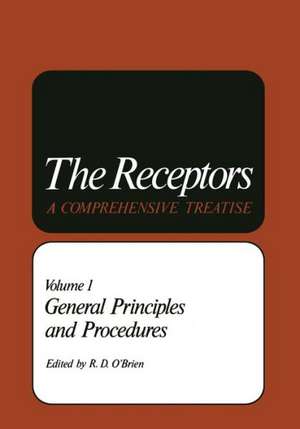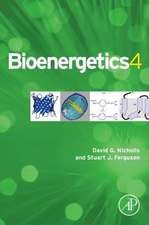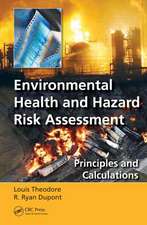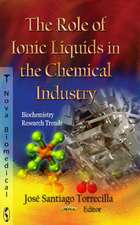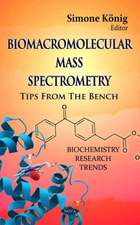General Principles and Procedures: The Receptors, cartea 1
Editat de R. D. O'Brienen Limba Engleză Paperback – 24 dec 2012
Din seria The Receptors
- 15%
 Preț: 697.15 lei
Preț: 697.15 lei - 5%
 Preț: 1934.34 lei
Preț: 1934.34 lei - 18%
 Preț: 1231.32 lei
Preț: 1231.32 lei - 18%
 Preț: 1236.99 lei
Preț: 1236.99 lei - 5%
 Preț: 1424.89 lei
Preț: 1424.89 lei - 18%
 Preț: 959.19 lei
Preț: 959.19 lei - 18%
 Preț: 950.84 lei
Preț: 950.84 lei - 5%
 Preț: 1106.69 lei
Preț: 1106.69 lei - 18%
 Preț: 1228.29 lei
Preț: 1228.29 lei - 18%
 Preț: 1229.91 lei
Preț: 1229.91 lei - 18%
 Preț: 969.13 lei
Preț: 969.13 lei - 18%
 Preț: 955.88 lei
Preț: 955.88 lei - 5%
 Preț: 1433.10 lei
Preț: 1433.10 lei - 15%
 Preț: 657.73 lei
Preț: 657.73 lei - 15%
 Preț: 645.79 lei
Preț: 645.79 lei - 18%
 Preț: 1218.69 lei
Preț: 1218.69 lei - 24%
 Preț: 1076.16 lei
Preț: 1076.16 lei - 15%
 Preț: 652.31 lei
Preț: 652.31 lei - 5%
 Preț: 1615.04 lei
Preț: 1615.04 lei - 18%
 Preț: 1556.46 lei
Preț: 1556.46 lei - 18%
 Preț: 1227.84 lei
Preț: 1227.84 lei - 15%
 Preț: 697.00 lei
Preț: 697.00 lei - 18%
 Preț: 944.19 lei
Preț: 944.19 lei - 18%
 Preț: 959.36 lei
Preț: 959.36 lei - 15%
 Preț: 647.27 lei
Preț: 647.27 lei
Preț: 397.16 lei
Nou
Puncte Express: 596
Preț estimativ în valută:
76.02€ • 82.60$ • 63.90£
76.02€ • 82.60$ • 63.90£
Carte tipărită la comandă
Livrare economică 21 aprilie-05 mai
Preluare comenzi: 021 569.72.76
Specificații
ISBN-13: 9781468409819
ISBN-10: 1468409816
Pagini: 364
Ilustrații: XVI, 345 p.
Dimensiuni: 178 x 254 x 19 mm
Greutate: 0.63 kg
Ediția:Softcover reprint of the original 1st ed. 1979
Editura: Springer Us
Colecția Springer
Seria The Receptors
Locul publicării:New York, NY, United States
ISBN-10: 1468409816
Pagini: 364
Ilustrații: XVI, 345 p.
Dimensiuni: 178 x 254 x 19 mm
Greutate: 0.63 kg
Ediția:Softcover reprint of the original 1st ed. 1979
Editura: Springer Us
Colecția Springer
Seria The Receptors
Locul publicării:New York, NY, United States
Public țintă
ResearchCuprins
1 Reconstitution of Membrane Transport Functions.- 1. Introduction.- 2. Reconstitution of Active and Passive Transport Systems.- 3. General Techniques of Reconstitution.- 4. What We Can Learn from Reconstitution.- 5. Reconstitution in Planar Bilayer Membranes.- References.- 2 The Pharmacon-Receptor-Effector Concept: A Basis for Understanding the Transmission of Information in Biological Systems.- 1. Introduction.- 2. Biological Action.- 3. Receptors and Receptor Sites.- 4. Pharmacon-Receptor Interaction.- 5. Spare Receptors.- 6. Structure and Action.- 7. Accessory Receptor Sites.- 8. Steric Structure and Action.- 9. Selectivity in Action.- 10. Differentiation in Closely Related Receptor Types.- 11. Receptor Binding and Receptor Isolation.- 12. Dualism in Receptors for Agonists and Their Competitive Antagonists.- 13. The Aggregation-Segregation Concept.- 14. Dual Receptor Model.- 15. Combination of Pharmaca.- 16. The Slope of the Concentration-Effect Curves.- 17. The Allosteric Receptor Model.- 18. Binding and Displacement on Two or More Independent Classes of Receptor Sites.- 19. Two-Site Model.- 20. Reflection.- References.- 3 The Link between Drug Binding and Response: Theories and Observations.- 1. The Response to Acetylcholine-Like Drugs.- 2. The Binding of Drugs to Acetylcholine Receptors.- 3. The Link between Drug Binding and Response.- References.- 4 Kinetics of Cooperative Binding.- 1. Overview.- 2. General Introduction.- 3. Model I: koff as a Linear Function of Occupancy.- 4. Application to the Insulin-Receptor System.- 5. Model II: kon as a Linear Function of Occupancy.- 6. General Discussion.- 7. A Guide to the Experimentalist.- Appendix A: Model I: Differential Equations and Solutions.- Appendix B: Addition of Fresh (Empty) Receptors.- Appendix C: Model II:Labeled Ligand Only.- Appendix D: Model II: Labeled and Unlabeled Ligands.- Appendix E: Optimization of Testing for Model II with ? > 0.- References.- 5 Distinction of Receptor from Nonreceptor Interactions in Binding Studies.- 1. Defining a Pharmacologic Receptor.- 2. Criteria for Receptor Interactions.- 3. The Problem of Relating Binding to Biological Responsiveness.- 4. Nonspecific Binding: Definition and Examples of Complications of Binding Data Analysis.- 5. Estimating the Affinity of the Unlabeled Ligand.- 6. Examples of Receptor-Like Nonreceptor Interactions.- 7. Conclusion.- References.- 6 Incorporation of Transport Molecules into Black Lipid Membranes.- 1. Introduction.- 2. Methodology.- 3. Mechanisms of Ion Permeability.- 4. Models of Interactions of Proteins with BLMs.- 5. Ionophorous Properties in BLMs of Functional Transport Molecules.- 6. The BLM as a Test System for Ionophorous Function of Isolated Membrane Proteins.- 7. Coda.- References.- 7 Visualization and Counting of Receptors at the Light and Electron Microscope Levels.- 1. Receptors at the Cell Membrane.- 2. The Labeling of Receptors for Localization.- 3. Cell and Tissue Autoradiography.- 4. Counting Receptors per Cell or per Synapse.- 5. Electron Microscope Methods for Visualization of Receptors.- 6. Fluorescence Marker Methods.- 7. Possibilities of Quantitation of Receptors in Immunocytochemical and Other Nonradioisotopic Techniques.- 8. Conclusions.- References.- 8 Problems and Approaches in Noncatalytic Biochemistry.- 1. Introduction.- 2. Measurement.- 3. Relation of in Vivo to in Vitro Properties.- References.
